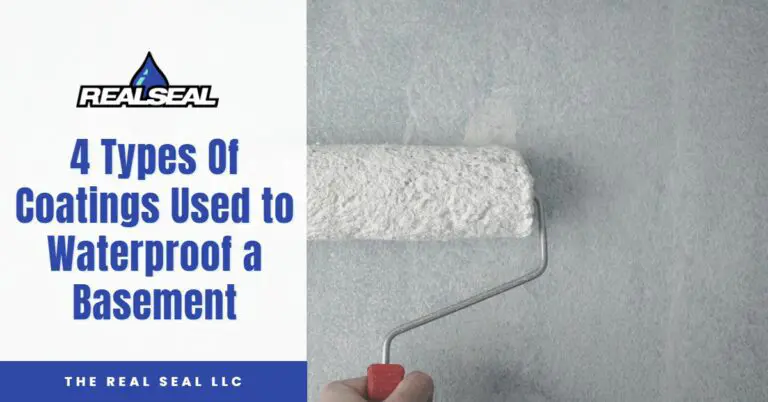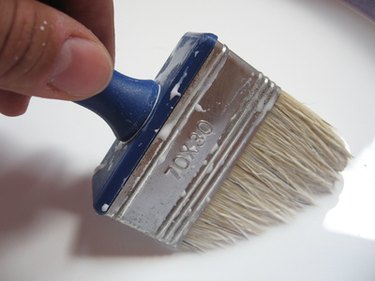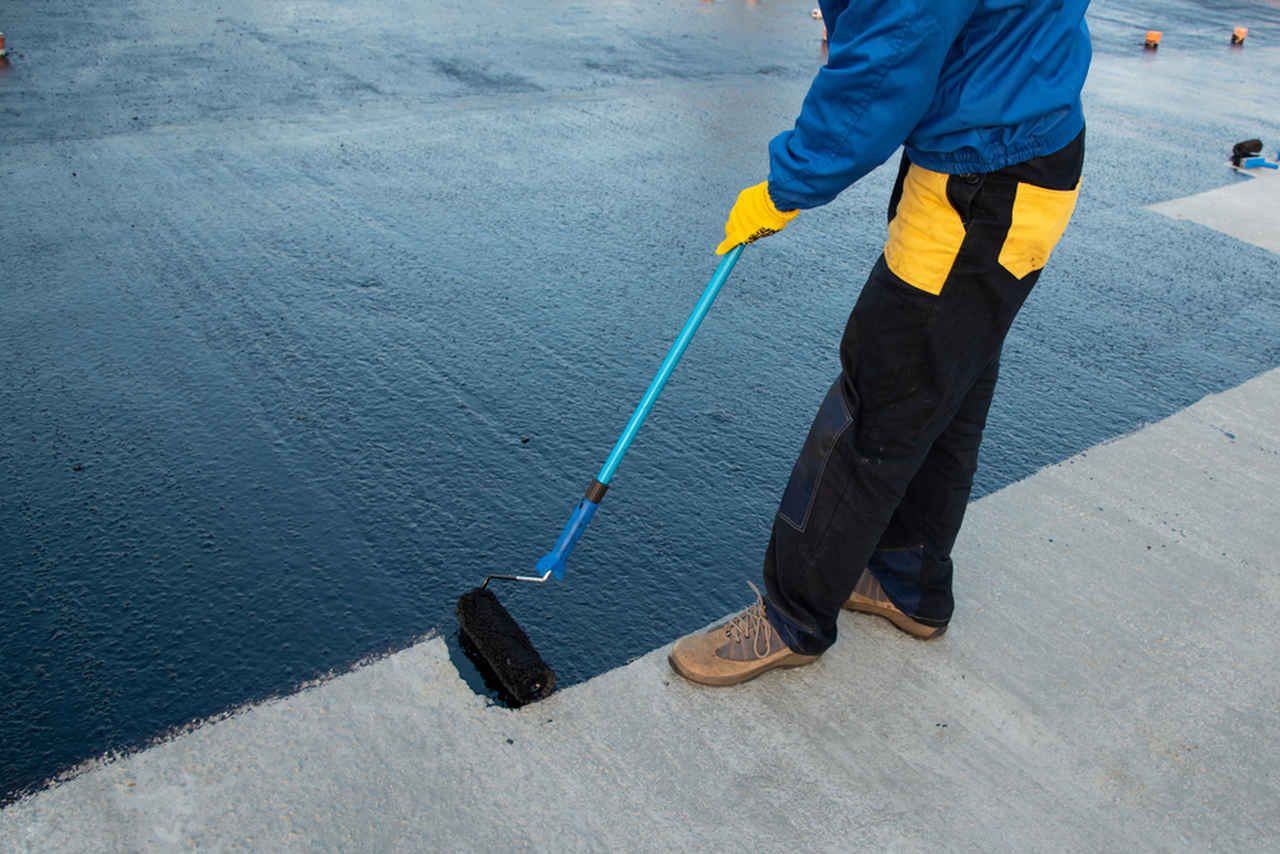There are several types of waterproof paint, including acrylic, epoxy, and oil-based paints. Each type serves specific applications and offers varying levels of durability and water resistance.
Waterproof paint is essential for protecting surfaces from moisture damage. It is commonly used in areas exposed to water, such as bathrooms, kitchens, and basements. Different formulations cater to various needs, making it crucial to choose the right type for your project.
Acrylic paints are versatile and easy to apply, while epoxy paints provide robust protection against harsh elements. Oil-based paints, on the other hand, offer a glossy finish and excellent adhesion. Understanding the distinctions between these types will help you select the best waterproof paint for your needs, ensuring long-lasting protection and a beautiful finish.

Credit: www.therealsealllc.com
Contents
- Introduction To Waterproof Paint
- Waterproof Vs. Water-resistant Paint
- Acrylic Waterproof Paint
- Epoxy Waterproof Coatings
- Latex-based Waterproof Paint
- Oil-based Waterproof Solutions
- Masonry Waterproofing Paint
- Polyurethane Sealants
- Natural And Eco-friendly Options
- Surface Preparation And Primer
- Maintenance And Longevity
- Common Mistakes To Avoid
- Frequently Asked Questions
- Conclusion
Introduction To Waterproof Paint
Waterproof paint is essential for protecting surfaces from moisture. It creates a barrier against water, ensuring longevity and maintaining aesthetics. This paint is widely used in various applications, from homes to industrial settings. Understanding its types and benefits helps in choosing the right product.
Importance For Durability
Waterproof paint offers several key benefits:
- Prevents Water Damage: Stops water from seeping into walls.
- Reduces Mold Growth: Keeps surfaces dry and inhibits mold.
- Enhances Longevity: Extends the life of painted surfaces.
- Improves Aesthetics: Maintains the look of surfaces over time.
Using waterproof paint is vital for areas prone to moisture. It is perfect for basements, bathrooms, and kitchens. Choosing the right type ensures maximum protection and durability.
Scope Of The Guide
This guide covers various types of waterproof paint. It explains their applications and benefits. Here’s what you can expect:
- Types of waterproof paint available
- Best practices for application
- Comparative benefits of different paints
- Common misconceptions about waterproof paint
This information helps in making an informed decision. Understanding waterproof paint enhances your home’s protection.

Credit: www.ehow.com
Waterproof Vs. Water-resistant Paint
Understanding the difference between waterproof and water-resistant paint is crucial. Both types protect surfaces but offer different levels of defense against moisture. This guide will help you choose the right option.
Key Differences
The terms “waterproof” and “water-resistant” often confuse many. Here are the main differences:
| Feature | Waterproof Paint | Water-Resistant Paint |
|---|---|---|
| Protection Level | Impermeable to water | Resists water but allows some penetration |
| Best Use | Basements, bathrooms, outdoor areas | Indoor walls, ceilings |
| Durability | Lasts longer in wet conditions | May need reapplication sooner |
| Cost | Generally more expensive | More budget-friendly |
Choosing The Right Option
Deciding between waterproof and water-resistant paint depends on your needs. Consider these factors:
- Location: Use waterproof paint in wet areas.
- Moisture Level: Assess how much moisture the surface will face.
- Budget: Choose based on your financial limits.
- Application: Some surfaces require specific types of paint.
Make sure to test samples on small areas. This helps determine the best option for your project. Pay attention to the specific instructions for application. Proper preparation ensures the best results.
Acrylic Waterproof Paint
Acrylic waterproof paint is a popular choice for various surfaces. It provides excellent protection against moisture and water damage. This type of paint is versatile and can be used both indoors and outdoors. Its quick-drying properties make it user-friendly. Let’s explore its properties, benefits, and ideal use cases.
Properties And Benefits
Acrylic waterproof paint has several key properties:
- Water Resistance: Protects surfaces from moisture.
- Flexibility: Adapts to temperature changes without cracking.
- UV Stability: Resists fading from sunlight exposure.
- Fast Drying: Dries quickly, allowing for multiple coats.
- Low Odor: Makes it safer for indoor use.
Benefits include:
- Durability: Long-lasting finish even in harsh conditions.
- Easy Application: Can be applied with a brush, roller, or spray.
- Variety of Colors: Available in many shades and finishes.
- Easy Cleanup: Clean tools with soap and water.
- Environmentally Friendly: Low in volatile organic compounds (VOCs).
Ideal Use Cases
Acrylic waterproof paint is suitable for various surfaces:
| Surface | Recommended Use |
|---|---|
| Walls | Interior and exterior applications |
| Wood | Decks, fences, and outdoor furniture |
| Concrete | Basements, driveways, and patios |
| Metal | Gates, railings, and outdoor equipment |
Choose acrylic waterproof paint for:
- Protecting homes from water damage
- Enhancing the beauty of outdoor spaces
- Maintaining structures in wet climates
Epoxy Waterproof Coatings
Epoxy waterproof coatings are popular for their strong protective qualities. They create a durable barrier against water. This type of paint is often used in basements, garages, and on concrete surfaces. Many homeowners choose epoxy for its resilience and long-lasting effects.
Strengths And Limitations
Understanding the strengths and limitations of epoxy coatings helps in making informed choices.
| Strengths | Limitations |
|---|---|
| Highly durable and resistant to wear. | Can be expensive compared to other options. |
| Excellent adhesion to various surfaces. | Requires proper surface preparation. |
| Creates a seamless waterproof barrier. | Limited flexibility can lead to cracking. |
| Resistant to chemicals and stains. | Long curing time before full strength. |
Application Techniques
Applying epoxy coatings correctly ensures the best results. Follow these steps for a successful application:
- Surface Preparation: Clean the surface thoroughly. Remove any dirt, grease, or old paint.
- Mixing: Follow the manufacturer’s instructions for mixing the epoxy. Ensure a proper blend.
- Application: Use a brush, roller, or spray. Apply evenly to avoid bubbles.
- Curing: Allow the coating to cure completely. This may take several days.
Always wear protective gear during the application. Proper ventilation is also important.
Latex-based Waterproof Paint
Latex-based waterproof paint is a popular choice for many surfaces. It provides excellent protection against moisture. This paint is made with water as a solvent, making it eco-friendly. It adheres well to various indoor surfaces. Let’s explore its advantages and how to apply it.
Advantages For Indoor Use
- Low Odor: Safe for indoor environments.
- Quick Drying: Dries faster than oil-based paints.
- Easy Cleanup: Wash brushes and tools with water.
- Flexibility: Expands and contracts with temperature changes.
- Durability: Resists peeling and fading.
Preparation And Application
Proper preparation ensures the best results. Follow these steps for a smooth application:
- Clean the Surface: Remove dust, dirt, and grease.
- Repair Damages: Fill cracks and holes with a suitable filler.
- Prime if Necessary: Use a primer for better adhesion.
- Apply the Paint: Use a brush, roller, or sprayer.
- Allow to Dry: Follow the manufacturer’s drying time.
For best results, apply two coats. This enhances waterproofing and durability.

Credit: www.baumerk.com
Oil-based Waterproof Solutions
Oil-based waterproof solutions are popular for their strength and reliability. They create a strong barrier against moisture. These paints are ideal for surfaces exposed to high humidity and water. Homeowners and builders often choose them for their durability.
Durability Factors
Oil-based paints offer exceptional durability. They can withstand harsh weather and physical wear. Here are some key durability factors:
- Resistance to Water: Oil-based paints repel water effectively.
- Longevity: These paints last longer than many alternatives.
- UV Protection: They protect surfaces from harmful UV rays.
- Scratch Resistance: Their hard surface resists scratches and scuffs.
Surface Compatibility
Oil-based waterproof solutions work well on various surfaces. They adhere to different materials easily. Here’s a breakdown of their compatibility:
| Surface Type | Compatibility |
|---|---|
| Wood | Excellent adhesion and protection |
| Metal | Prevents rust and corrosion |
| Concrete | Seals and protects from moisture |
| Brick | Enhances durability and appearance |
Choose oil-based waterproof solutions for effective protection. They enhance the lifespan of surfaces while maintaining a clean look.
Masonry Waterproofing Paint
Masonry waterproofing paint is essential for protecting brick, concrete, and stone surfaces. It prevents water damage and keeps structures safe. This type of paint forms a barrier against moisture. It is ideal for both indoor and outdoor applications.
Specialized Formulations
Masonry waterproofing paints come in different formulations. Each type serves unique purposes. Here are some key features:
- Elastomeric Coatings: Stretchable and flexible. Ideal for surfaces with movement.
- Silicone-Based Paint: Offers superior water repellency. Resists mold and mildew.
- Acrylic Paint: Easy to apply. Provides good protection against moisture.
| Type | Key Benefits |
|---|---|
| Elastomeric Coatings | Flexible, ideal for movement |
| Silicone-Based Paint | Resistant to mold, excellent repellency |
| Acrylic Paint | Easy application, good moisture protection |
Exterior Protection
Using masonry waterproofing paint offers robust exterior protection. It shields against harsh weather conditions. Here are some benefits:
- Prevents Water Infiltration: Stops moisture from seeping into walls.
- Reduces Efflorescence: Minimizes white powdery stains on surfaces.
- Enhances Appearance: Provides a fresh, clean look to structures.
- Increases Longevity: Extends the life of masonry surfaces.
Choose the right masonry waterproofing paint for effective protection. Select based on your specific needs.
Polyurethane Sealants
Polyurethane sealants are popular for waterproofing. They create a strong, flexible barrier. This barrier protects surfaces from moisture and water damage. Polyurethane is suitable for various applications, from home improvement to industrial use.
Versatility In Waterproofing
Polyurethane sealants offer great versatility. They work on many surfaces, including:
- Wood
- Concrete
- Metal
- Glass
- Plastic
These sealants can be used indoors and outdoors. They resist UV rays and extreme temperatures. This makes them ideal for:
- Roofing
- Basements
- Bathrooms
- Decks
Polyurethane sealants also bond well. They fill gaps and cracks effectively. This prevents water from entering and causing damage.
Application Tips
Applying polyurethane sealants is simple. Follow these tips for the best results:
- Clean the surface thoroughly.
- Ensure the area is dry.
- Use a caulking gun for even application.
- Apply a steady bead of sealant.
- Tool the sealant for a smooth finish.
- Allow it to cure as per the instructions.
Wear gloves and goggles for safety. Proper ventilation is essential during application. Store unused sealant in a cool, dry place.
Natural And Eco-friendly Options
Choosing natural and eco-friendly waterproof paint benefits both you and the environment. These paints use sustainable materials. They offer safety without harmful chemicals. Great for homes, schools, and public buildings, these options are gaining popularity.
Sustainable Choices
Many brands focus on sustainability. They use ingredients that are safe for the earth. Here are some popular natural and eco-friendly waterproof paints:
- Clay-based Paints: Made from natural clay and pigments.
- Milk Paint: Composed of milk protein, lime, and natural pigments.
- Plant-based Paints: Derived from soy, corn, and other plants.
- Low-VOC Paints: Contains fewer volatile organic compounds.
These options are non-toxic. They reduce indoor air pollution. They also help the planet by using renewable resources.
Performance Considerations
Performance is key in waterproof paints. Here’s how natural options stack up:
| Type of Paint | Durability | Water Resistance | Application |
|---|---|---|---|
| Clay-based | Medium | Low | Easy |
| Milk Paint | Medium | Medium | Moderate |
| Plant-based | High | High | Moderate |
| Low-VOC | High | High | Easy |
Consider the specific needs of your project. Some options offer great durability. Others may require more frequent touch-ups. Choose wisely based on your environment.
Surface Preparation And Primer
Surface preparation is vital for effective waterproof paint application. Proper prep ensures the paint adheres well and performs effectively. Skipping this step can lead to peeling or flaking.
Ensuring Adhesion
Good adhesion is crucial for waterproof paint. Follow these steps for best results:
- Clean the surface thoroughly.
- Remove dirt, grease, and old paint.
- Use a wire brush or scraper for tough spots.
- Rinse well and let dry completely.
Check for any cracks or damage. Repair them before applying the primer.
Primer Selection
Choose the right primer for your surface. Consider these options:
| Surface Type | Recommended Primer |
|---|---|
| Wood | Oil-based primer |
| Metal | Rust-inhibiting primer |
| Concrete | Water-based acrylic primer |
| Drywall | Shellac-based primer |
Using a suitable primer enhances paint durability. Always follow the manufacturer’s instructions for application.
Maintenance And Longevity
Waterproof paint protects surfaces from moisture damage. Proper maintenance ensures its effectiveness over time. Regular care keeps your painted areas looking fresh and functional.
Regular Care Tips
To maintain the quality of waterproof paint, follow these care tips:
- Clean Surfaces: Dust and dirt can accumulate. Wipe surfaces with a damp cloth.
- Avoid Harsh Chemicals: Use mild soaps for cleaning. Avoid abrasive cleaners.
- Inspect Regularly: Check for cracks or peeling. Address issues quickly.
- Keep Surfaces Dry: Ensure areas remain dry. Moisture can weaken the paint.
Reapplication Intervals
Waterproof paint needs reapplication for maximum protection. Here’s a simple guide:
| Surface Type | Recommended Interval |
|---|---|
| Exterior Walls | Every 5-7 years |
| Decks and Patios | Every 3-5 years |
| Bathrooms | Every 2-3 years |
| Basements | Every 5 years |
Keep track of reapplication dates. This helps maintain the paint’s effectiveness. Ensure your surfaces remain protected from moisture.
Common Mistakes To Avoid
Choosing the right waterproof paint is crucial. Many people make mistakes that lead to poor results. Knowing these common errors can save time and money. Below, we discuss two major areas of concern: selection errors and application pitfalls.
Selection Errors
Picking the wrong type of waterproof paint is a common mistake. Here are key points to consider:
- Ignoring the Surface Type: Different surfaces require different paints.
- Overlooking Climate Conditions: Weather affects paint performance.
- Choosing Low-Quality Products: Cheap paint often fails quickly.
- Not Checking for Mold Resistance: Mold can grow under poor paint.
Before purchasing, always read the label. Understand the paint’s specifications and features. Make sure it matches your needs.
Application Pitfalls
Improper application can ruin even the best paint. Avoid these common pitfalls:
- Skipping Surface Preparation: Clean and dry surfaces ensure better adhesion.
- Applying Too Thickly: Thick layers can lead to peeling.
- Ignoring Temperature Guidelines: Paint needs specific temperatures to cure properly.
- Forgetting to Use Primer: Primer enhances the paint’s effectiveness.
Proper application makes a significant difference. Take your time and follow the instructions carefully. This ensures the best results for your waterproof paint project.
Frequently Asked Questions
Which Paint Is Waterproof?
Acrylic latex paint and oil-based paint are both waterproof options. They provide excellent protection against moisture. For outdoor surfaces, consider marine-grade paint for enhanced durability. Always check labels for specific waterproof features before purchasing.
What Is The Best Paint To Keep Water Out?
The best paint to keep water out is a high-quality exterior acrylic latex paint. It offers excellent water resistance and durability. For added protection, consider using a waterproofing primer before painting. Always choose products specifically designed for exterior surfaces to ensure long-lasting results.
How Long Does Waterproofing Paint Last?
Waterproofing paint typically lasts between 5 to 10 years. Its longevity depends on factors like surface preparation, environmental conditions, and application technique. Regular maintenance can extend its lifespan. Always check the manufacturer’s recommendations for best results.
What Kind Of Paint Is Waterproof For A Shower?
For a waterproof shower, use epoxy paint or specialized bathroom paint. These options resist moisture and mold effectively. Always ensure proper surface preparation for optimal adhesion. Check for mildew-resistant formulas to enhance durability. Choose products labeled specifically for wet areas for the best results.
Conclusion
Choosing the right type of waterproof paint can significantly enhance your space. Whether for interior or exterior use, each option offers unique benefits. Consider your specific needs and the environment. With the right choice, you can protect surfaces effectively and ensure lasting results.
Invest wisely for a durable finish.
